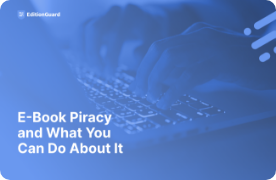
Many authors and publishers are hesitant to invest in digital rights management (DRM) solutions. In failing to do so, they’re putting themselves at risk of e-book piracy. According to a UK study,
up to 76% of popular textbooks were available online in pirated form. And it’s far from just frugal students who download pirated content. So, how can authors across the globe help protect their property? One option is
digital watermarking.
What is Digital Watermarking?
Digital watermarks are often used in images, usually in the form of a semi-transparent overlay of the owner’s name or brand. But digital multimedia content requires a different kind of watermark. Techopedia
defines digital watermarking as a method of embedding data into multimedia content for the purpose of verifying the credibility of the content or recognizing the identity of the owner of digital content.
For e-book publishing purposes, a watermark is often an overlay in the e-book that includes the purchaser’s personal information. Watermarks can also include publisher or author information.
The primary function of digital watermarking is to identify the owner of the content. Watermarks ensure copyright protection and enable tracking the source of a book or media.
Watermarks can also be hidden, invisibly embedded in the code of the e-book.
Visible or Invisible
Authors or creators of digital content can choose either visible or invisible watermarks. Visible watermarks are often comprised of logos and text while invisible versions are embedded into the code of the e-book or document.
It should be noted that visible watermarks do not alter the code in a file, and rely on purchaser or user entered information.
While watermarks may not prevent unauthorized reproduction, they help authors discourage
e-book piracy since the author or owner’s information is embedded in the content. Watermarking also allows authors to track unauthorized use of content and identify pirates who redistribute licensed material.
Some publishers use a unique code for each book copy, enabling product tracking without displaying the purchaser’s information. Alternatively, a reader’s name, email, address, or other identifying information can be used.
How Digital Watermarking Works
As the Digital Watermarking Alliance explains, digital watermarking is a
form of content identification that gives consumers the freedom to use copyrighted materials within legal parameters.
Digital watermarking highlights product ownership without limiting how consumers can read their downloaded e-books. Consumer convenience is a fundamental tenet of digital watermarking, making it a natural choice for many authors.
How “Social DRM” Can Help Authors
At EditionGuard, we offer social DRM technology that embeds visible watermarks into your e-books. Here we’ll highlight the benefits of our social DRM option.
Save Time
Setting up social DRM requires little time investment. That’s because the framework relies on customer input to create and place custom watermarks. The buyer must enter information such as their name, email address, and phone number before downloading the book. While it’s a short step for consumers, this method saves time for authors and allows for easy tracking later if a consumer pirates content.
With all the hours that go into writing, formatting, and marketing an e-book, choosing digital watermarking is a convenient and efficient choice for DRM. Saving time and boosting productivity through bypassing intricate security steps also saves money.
Device Compatibility
DRM solutions using encryption often limit how consumers can read e-books, such as only allowing use on one device, app or platform. Restricting the audience of a book to those with one type of e-reader, for example, may mean leaving money on the table when it comes to sales.
This is one of the side-effects of Adobe DRM protection, which restricts your e-books to specific devices. Social DRM has no such restrictions. That means the purchaser can read your material on any e-reader or application.
Buyers can take their books anywhere with any device, but the moment they share content unlawfully, you can track it down and stop it.
Software Choice
With endless software choices and more becoming available every day, consumers often have set preferences when it comes to e-book reading. Fortunately, social DRM places no limit on software usage, either.
Consumers can download your e-books and use any software to read them. The digital watermarks, however, remain embedded in the book.
Instantaneous Downloads
Once a buyer enters their personal information, their e-book download is instantaneous. There is no extra time or a waiting period involved with downloads.
Customer Trust
When authors or publishers use restrictive DRM protection methods, they risk alienating consumers who feel as if they aren’t to be trusted. No author wants to lose sales to unlicensed copies of books showing up online, but authors also want to avoid implicitly accusing their customers of illicit acts.
Social DRM is often the top choice for authors whose reader base may feel sensitive toward higher measures of security.
Because digital watermarking still allows consumers the flexibility they enjoy, it is less intrusive than other more restrictive forms of DRM. In the end, an author’s readers dictate how successful an e-book or a series becomes, so catering to their needs is a smart sales strategy.
As a journalist for The Guardian wrote, treating
every consumer as a potential criminal is not the goal of DRM. Unintrusive DRM that adapts to an author’s unique customer base has the best chance of inspiring loyalty.
Effectiveness
Does social DRM really reduce piracy? While there are no recent studies on the effectiveness of watermarks against media piracy, experts maintain that watermarking does help reduce piracy—otherwise big-name publishers wouldn’t use it. According to Publishers Weekly’s expert, certain anti-piracy measures resulted in a
14% increase in e-book sales.
The fact that a digitally watermarked e-book contains the buyer’s personal information may not physically prevent them from making unauthorized copies, but it may prevent dishonest buyers from attempting to profit from an author’s work.
Legal Protection
Digital watermarking is an extension of traditional watermarks. According to
LegalZoom, digital watermarks that remain embedded in content as pirates redistribute it
provides evidence of copyright violation.
Copyright holders can pursue hackers or pirates for copyright infringement. Digital watermarking is a means of enhancing copyright protection that facilitates legal recourse if e-books are duplicated or shared illegally.
Other Types of DRM for E-Books
Beyond digital watermarking, there are other types of DRM that can help protect e-books from unauthorized use. The two most common are password protection and encryption.
Password Protection
Apps such as Adobe Acrobat or Preview for Mac offer the option for password protection for PDF and EPUB files. Passwords are a straightforward way to grant access to buyers or authorized users. However, various services and solutions can remove password protection. That means password protection alone may not be enough to protect e-books.
Additionally, password protection does not stop consumers from sharing purchases with friends and family if the password is also shared.
Encryption
Industry-standard DRM solutions such as Adobe DRM use secure encryption to protect e-books. Although encryption cannot provide absolute protection, DRM encryption is an ever-evolving tool that aims to stay a step ahead of hackers and potential pirates.
Encryption dictates what consumers can do with an e-book such as preventing them from sharing an e-book digitally or choosing to print or copy portions of it.
Due to its advanced technology, DRM encryption is often more expensive than other security solutions. It’s also one of the most effective.
If you’re looking for the most robust and restrictive protection for your e-book, Adobe DRM from EditionGuard may be the right choice for you.
In Summary
Understanding the different available DRM options can prove frustrating, but experts agree that protecting your content is crucial for maintaining e-book sales. At the same time, choosing the right means of copyright protection can mean the difference between making and losing a sale.
While digital watermarking is a smart digital rights management solution for many authors, its suitability depends on the type of content you publish, the audience you aim to address, and your methods of distribution.
Overall, social DRM is ideal for writers with an audience that may not mind personalized watermarking but may be
wary of other DRM measures.
Especially for indie authors and self-publishers, avoiding audience alienation is a crucial part of DRM strategy. Overall, digital watermarking caters to e-book authors and publishers seeking to protect their work while still offering maximum convenience and device compatibility to their readers.
 Many authors and publishers are hesitant to invest in digital rights management (DRM) solutions. In failing to do so, they’re putting themselves at risk of e-book piracy. According to a UK study, up to 76% of popular textbooks were available online in pirated form. And it’s far from just frugal students who download pirated content. So, how can authors across the globe help protect their property? One option is digital watermarking.
Many authors and publishers are hesitant to invest in digital rights management (DRM) solutions. In failing to do so, they’re putting themselves at risk of e-book piracy. According to a UK study, up to 76% of popular textbooks were available online in pirated form. And it’s far from just frugal students who download pirated content. So, how can authors across the globe help protect their property? One option is digital watermarking.
 Many authors and publishers are hesitant to invest in digital rights management (DRM) solutions. In failing to do so, they’re putting themselves at risk of e-book piracy. According to a UK study, up to 76% of popular textbooks were available online in pirated form. And it’s far from just frugal students who download pirated content. So, how can authors across the globe help protect their property? One option is digital watermarking.
Many authors and publishers are hesitant to invest in digital rights management (DRM) solutions. In failing to do so, they’re putting themselves at risk of e-book piracy. According to a UK study, up to 76% of popular textbooks were available online in pirated form. And it’s far from just frugal students who download pirated content. So, how can authors across the globe help protect their property? One option is digital watermarking.


